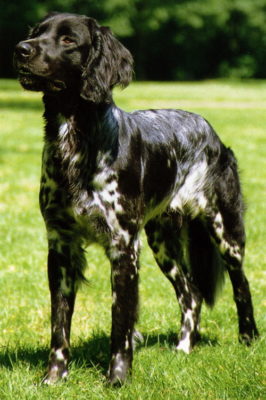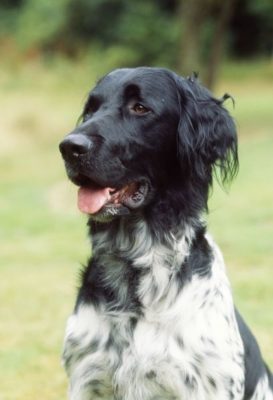Large Münsterländer
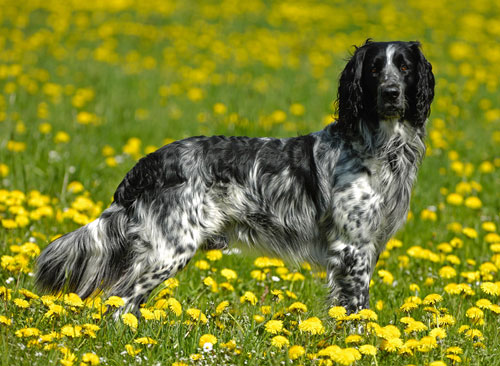
The temperament of the Large Münsterländer is incredibly mild. It is a curious and active dog, which is strongly attached to its owner. German hunters have always valued the skills of the Large Münsterländer. Excitement, hunting instinct, a developed sense of smell, and the desire to go forward to the goal – the exact description of this “workhorse”. A huge plus of the breed is considered a quick response of the dog to the owner’s commands.
Table of Contents
Breed Information
| Another Name | Großer Münsterländer, Großer Münsterländer Vorstehhund |
| Origin | Germany |
| Height | Males 60-67 cm Females 58-65 cm |
| Weight | 23-32 kg |
| Fur | Long |
| Color | Black and white |
| Lifespan | 10-12 years |
| FCI Classification | Pointing Dogs |
| Group | Hunting dogs |
| Price | From $900 |
Breed Photos
Origin History
The Large Münsterländer is a relatively young breed of large hunting dog. In its native Germany, it is in great demand and is considered a universal dog. Moreover, the Large Münsterländer is considered by cynologists to be a model and classic representative of the leash dog.
At the beginning of the XIX century, the breed dogs were distributed in the city of Munster, to which they owe their name. The closest relative of the Great Munster is the German Langhaar, which was used for breeding the new breed. At that time, German hunters lived with the idea of creating a legal dog that would excel in hunting feathered and small game. The main feature of the Large Münsterländer is the ability to give a unique sign. The dog freezes on the spot in case of detection of prey.
In Germany, the German Kennel Club recognized the breed only in 1919, when enthusiastic amateurs founded the Münsterländer Club. In 1966, dog breeder Kurt von Kleist took several representatives of the breed to the USA. After that and began the active spread of the Great Munsterländer. And its official standard and recognition by the Fédération Cynologique Internationale, the Large Münsterländer got just recently, in 2013. The Large Münsterländer is popular not only in Germany but is valued by hunters in Canada and England.
Appearance
Like other dogs of the Continental Leopard type, the Great Munster looks very imposing and even noble. He always keeps his head up high; the build is strong and harmonious. The body is square. Not a very big head, not wide, but long. The transition from the forehead to the muzzle is weak. The ears are close to the head, hanging, of medium length. The eyes are oval-shaped, dark in color, with a very attentive and concentrated look. The neck is graceful, solid, and with a curve characteristic of the breed. Straight back with a wide loin.
The abdomen is moderately trimmed. Limbs of dry type, moderately long with developed musculature. The tail is arranged as if it were an extension of the back: thick at the base but tapering toward the end. The coat of the Large Münsterländer is thick and long but not of equal length all over the body. Longer on the back, back of the limbs, tail, and ears. Acceptable colors: Absolutely all variations of black and white. Preferably when the head is entirely black, and there are black and white spots all over the body. There is also a variation of brown and white coloration among the Large Münsterländers, but it does not fall under the breed standard.
Character
The temperament of the Large Münsterländer is incredibly mild. It is a curious and active dog, which is strongly attached to its owner. German hunters have always valued the skills of the Large Münsterländer. Excitement, hunting instinct, a developed sense of smell, and the desire to go forward to the goal – the exact description of this “workhorse”. A huge plus of the breed is considered a quick response of the dog to the owner’s commands. Among the advantages is a thick coat that protects the dog from all weather conditions and temperature extremes.
If you want to buy a Large Münsterländer, you must understand that it is a hunting dog with certain requirements. He needs a spacious area. It means that he is not suitable for apartment life. The Large Münsterländer feels great in the company of a large friendly family and gets along well with children. Distrustful of strangers, but not aggressive. Therefore, do not count on him as a reliable guardian of your home. Also does not tolerate loneliness and needs long walks and training.
Care
The care of the Large Münsterländer is not complicated at all. As for the coat, the molting of the breed is seasonal. Due to its thickness and heterogeneity, it is better to comb out the hair with a special brush every few days. Pay special attention to the care of the ears. If you use a Large Münsterländer as a hunting companion, dirt and water may accumulate in the pet’s ears. It leads to the spread of infections and inflammation.
It is not recommended to bathe your pet more than once every four months. The claws of an active dog tend to shrink on its own. If this is not enough, trim them monthly.
Training
Remember that a well-behaved dog is always the result of hard work. The Large Münsterländer is not particularly stubborn. Owners note it’s easy to learn, good memory, and a tendency to follow commands. Early socialization is also needed because the hunting instinct for small games is incredibly high.
If you want to keep more than one dog in the house and any small animals – take care of your pet’s socialization. Nowadays, you can often see Large Münsterländers at various competitions, such as agility and Frisbee. There they show good results and are very responsive to all commands of the trainer.
Common Diseases
Studies of the Large Münsterländer by experienced cynologists and veterinarians have not recorded any severe genetic diseases. The only condition that is characteristic of almost all large dogs is hip and elbow dysplasia.
Nutrition
The diet of a Large Münsterländer must be balanced and contain a sufficient amount of protein. It is the main component of nutrition and a source of energy for such a large and mobile dog. The portion size should only be chosen based on the dog’s lifestyle. Your veterinarian can help you decide between natural food and dry food. If in doubt about what’s best for your dog, talk to your vet.
 Spinone Italiano
Spinone Italiano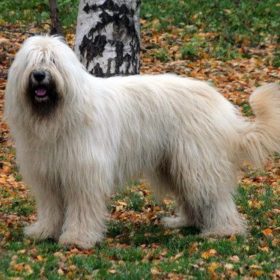 South Russian Ovcharka
South Russian Ovcharka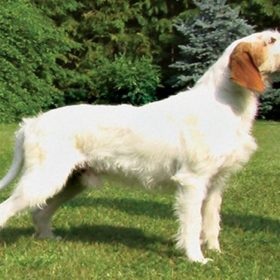 Istrian Coarse-haired Hound
Istrian Coarse-haired Hound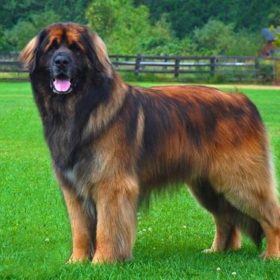 Leonberger
Leonberger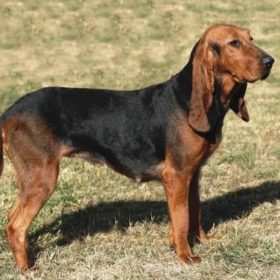 Bruno Jura Hound
Bruno Jura Hound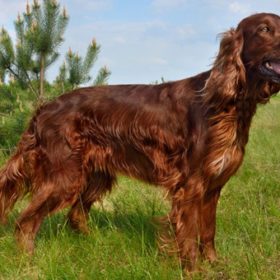 Irish Setter
Irish Setter